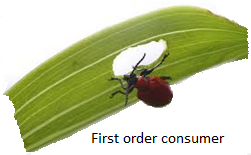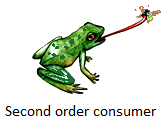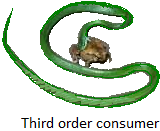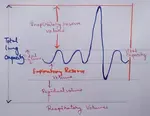Producers and Consumers
We will understand the about the concept of producers and consumers.
We know that green plants make their own food and they use only a part of this food for their growth. The rest of the food is preserved for animals. Thus the plants are known as the producers while animals are known as the consumers.
The plant-eating or herbivorous animals eat the food preserved by the plants.
So the herbivorous animals are the first order consumers.
First order consumers depend directly on green plants for food. Herbivorous animals like elephant, camel, cow, buffalo, deer, sheep, goat, rabbit etc. are the first order consumers.
An insect eats green leaves so it is first order consumer.
Some flesh eating or carnivorous animals eat flesh of the first
order consumers or herbivorous creatures, for example, rabbit, goat,
deer, sheep etc. So they are called the second order consumers.
A frog eats insects, so it is second order consumer.
Some carnivores eat other carnivore animals. There are some
carnivores that eat up the second order consumers. They are termed as
the third order consumers.
A snake eats a frog, so it is third order consumer.
Thus considering the plants and animals as producers and consumers we conclude that all animals depend directly or indirectly on green plants for food and animals help the plants to grow.
From Producers and Consumers to HOME PAGE
Recent Articles
-
Regulation of Respiration | Respiratory Centres | Inspiratory Area |
Oct 14, 25 12:13 AM
Respiratory Centre is the area that controls the rate of respiration and it is observed to be located in medulla oblongata and pons. Respiratory Centre has the following will dispersed components like… -
Explain Transport of Gases | External Respiration | Tissue Respiration
Oct 09, 25 11:35 PM
In humans gaseous exchange is completed in the following ways the steps are - External Respiration or Breathing - Breathing in false taking in of Oxygen and giving out of carbon dioxide in the body. M… -
Kind and Number of Teeth | Location of Teeth in Mouth | Care of Teeth
Sep 11, 25 12:52 AM
Kind and Number of Teeth -
The Gaseous Exchange | Transport of Oxygen | Haldane Effect |
Sep 10, 25 02:44 PM
Oxygen carrying capacity of blood is 20 ml for 100m but 3% of dissolved in plasma and 97% of the oxygen combines with haemoglobin to form a loose reversible Complex called oxyhaemoglobin and is transp… -
Respiratory Volumes and Capacities | Tidal Volume | Dead Space
Sep 10, 25 02:46 AM
Explain respiratory volumes and capacities: Tidal Volume - Tidal volume is the volume of air inspired or expired in relaxed or resting position. Amount of tidal volume is about 500 m and it consists o…









New! Comments
Have your say about what you just read! Leave me a comment in the box below.